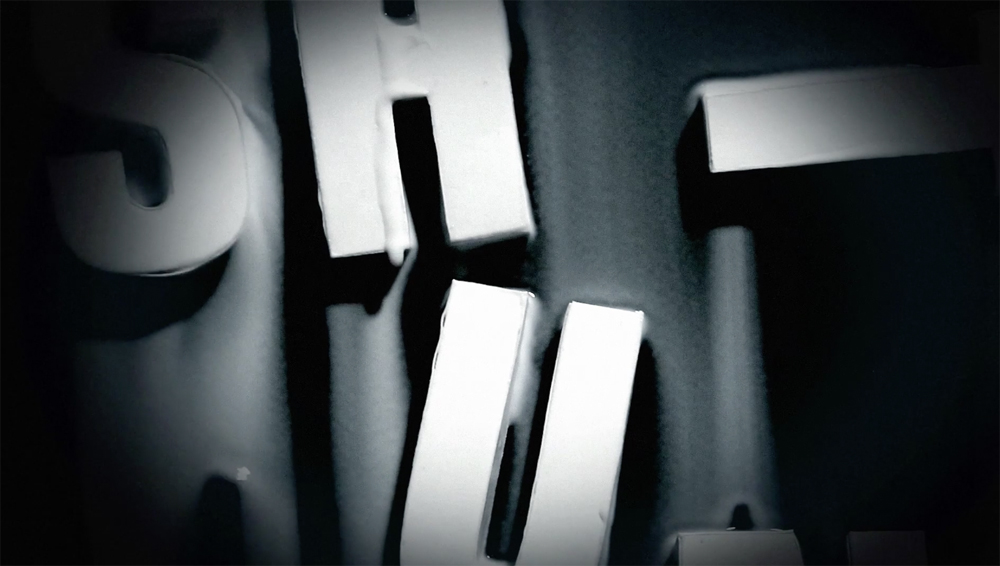
After a five year break to concentrate on family and home life, Alan Wilder returned to his studio project, Recoil, in September 2005. His first priority was to update The Thin Line and re-aquaint himself with the business of writing, arranging and recording music. In the fast-moving world of technology, five years out of the loop can seem like an eternity.
I’d literally forgotten how to work most of the equipment! Mainly operating the software, like ‘Logic Audio’. My computer was also well out of date as was most of the software installed on it.
In terms of hardware, he chose to install an Apple G5 Dual 2.7 Ghz with 2 x 250Gb Serial ATA hard drives, 2 new 22″ LCD displays and Digidesign’s Pro Tools HD3 accel. With this, he ran the latest in digital audio software: Apple’s Logic Pro 7.1 music creation and audio production package, Pro Tools 6.9, Ableton Live 5.0 and, amongst others, Waves Platinum TDM processing plug-In bundle.
“I spent the first 3 months just coming to terms with all the new gear, fiddling about with the software and getting to know Ableton Live which I ended up running as a slave, used mainly for time-stretching passages of performance and for its effects. It’s a little soul destroying and frustrating just bringing yourself up to speed when all you really want to do is get stuck in.”
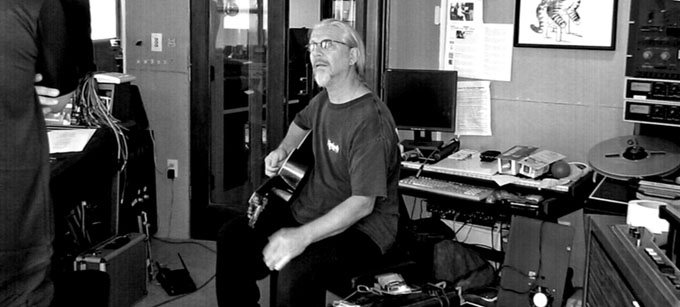
During the winter months of 2006, despite the learning curve, Alan managed to compile some new material and by the Spring began to look towards finding some kind of vocal contributions.
It was by google-ing ‘Blues singer/songwriter’ that he came across Joe Richardson, a Delta bluesman and guitarist based in Austin, Texas. Joe’s immediate appeal came from his distinctive vocal tone and stripped-back style but upon closer inspection, the dark mood and accompanying subject matter seemed tailor-made for Recoil. Alan e-mail’d Joe directly and received an enthusiastic – if somewhat surprised – response.
Says Alan “That’s when the internet really comes into its own. There is no way I could have known about Joe without the help of a search engine. I listened to hundreds of singers this way but it was Joe’s voice that leapt out of the speakers. He sounded exactly like the person I’d been hearing in my mind when I started working on the music. The thing was, I almost didn’t send the mail! When I saw his pictures on his web site, I thought he probably wouldn’t be interested in what I was doing and might be sort of grumpy or stuck in his ways. How wrong I was and how glad I am now that I did press the ‘send’ button.”
Says Joe “I was sitting at the computer one day when an e-mail popped up. It was from Alan Wilder – very brief, stating that he liked my song writing and singing and wondered if I would be interested in a collaboration. I had heard of his name but couldn’t remember from where. When I heard the music I thought “Wow”! I’ve been accused of leaning too much toward the darker side of things so I thought it might be a cool collaboration.”
Within weeks, Joe had listened to previous Recoil LPs and also Alan’s current work in progress – five potential tracks that he felt would suit Joe’s voice.
“Alan had some rough ideas without lyrics and I just wrote words and melodies that suited the mood he had already created. He didn’t pull the reigns in on me in any way so I was completely free to do whatever I felt. This made things really easy creatively.”
It was in May 2006 that Alan, Paul Kendall (engineer and sound designer) and Hepzibah Sessa (the missus and PA) travelled to Austin to work with Joe at Texas Treefort Studios, owned by Jack and Susie Rock.
Hep: “I remember the journey being quite eventful. I think we travelled with Delta or some other American airline and I can distinctly recall our collective alarm when we encountered the cabin crew. They were very definitely left-overs from the ‘70s when it was de rigour for air hostesses to sport big hair with Max Factor’s entire range of ‘exciting colours and shades’ trowel’d onto their faces. Head trolley-dolly looked like the lead singer of Twisted Sister and her ageing counterparts were most-likely members of a Tubes tribute band when not serving drinks and terrorising passengers on trans-atlantic flights.
Being required to reclaim all our luggage and re-check in at Dallas resulted in missing our on-going flight to Austin, so we killed an hour in the bar watching the paranoid comings-and-goings of a post-9/11 airport. The entire complex was swarming with troops home on leave, roaming around the airport in what looked like Khaki baby-gros. Every centimetre of available space was bedecked with flags and signs declaring victory against nasty transgressors like the French (‘Freedom Fries’ on sale here!!!).
Unfortunately for them, and us, stringent security measures (which required everyone to strip virtually naked) ensured lengthy queues as Uncle Sam’s brave boys tried to undo their 18-hole desert boots. This should have made for a great slapstick comedy routine (gruff sergeants getting tangled up in their laces, gnarled lieutenants falling over in their underpants etc.) but most of it was conducted in unnerving silence due to the predominance of huge signs declaring “No laughing/smiling/joking or we will shoot you” – or words to that effect. As you can imagine, this entire scenario is very difficult for us English because of the combined embarrassment of disrobing in front of complete strangers and the quite blatant promise of an undignified exit from the world. “I know I’m going to get hassled…” grumbled PK “they always single me out”. And sure enough, he was ordered to pass through a strange ‘blowing’ machine, like a huge hairdryer. We never did find out why.
Eventually we made it to Austin where Joe met us, and relief came when we discovered that he wasn’t a racist redneck, nor a born-again crimbo (let’s face it – we knew nothing about him at the time). In fact he was perfectly charming and very funny. After a brief journey into the hills outside the city, we realised the session was going to be a success when we were met by studio owner Jack brandishing perfect Moscow Mules as welcoming gifts.”
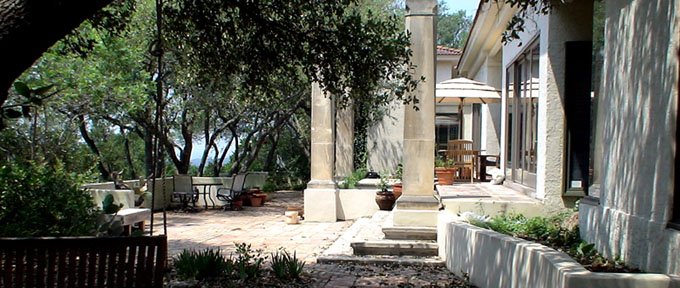
Assisted by engineer Jim Vollentine, over a week, the musicians laid down vocals and backing tracks for five of Alan’s tracks and three of Joe’s (that Alan intended to re-work back in England), together with various guitar and harmonica parts. Alan was keen to record drummer Richard Lamm and bassist John Wolfe (who perform with Joe as The Joe Richardson Express) to give the tracks an element of performance as well as providing additional material for loops and samples.
Alan: “Like any session where one is working with others for the first time, there is bound to be a degree of ‘feeling each other out’, you know – understanding the humour, developing the studio banter and so on. I decided to ease into it by getting the whole band in and recording drums and bass first. By the end of the week, we were quite comfortable and in fact, recorded most of Joe’s vocals on the last day. The sum of what we achieved during the week outweighed what I’d expected and I actually came away with quite a lot of bonus material. Everything was recorded to multitrack (for that special tape sound) and then transferred into ProTools. I managed to take the entire session home on a palm-sized hard drive!”
Joe: “It all went so easy and so quickly and Alan made the whole thing a real pleasure so the entire process couldn’t have been more fun or easy. He’s a creatively gifted person and just an all around nice guy!”
An impressive collection of vintage valve equipment was on hand to deliver that little extra to the session.
Alan: “There was an obscene amount of equipment at Jack’s place – too much to fully explore given the limited time we had. PK’s jaw dropped like a small child let loose in the sweety shop.”
PK: “I can honestly say that I have never, ever entered a studio with so much high-quality vintage equipment. It was as though I’d died and awoken in valve heaven. More Ureis than hot dinners, Pye, Fairchild, Telefunken, Neve and on and on. Then there were the guitar amps; a collection of more than 10 classic sounding monsters from an original Gibson combo, to a couple of Magnatones which I’d never seen, let alone heard, and when I did they produced the sweetest overdrive tremolo imaginable. I feel honoured to have been given the chance to see this place.”
Says Hep “The session was a delight all round – save for the enormous welts that we all picked up from the oversized Texan mosquitos who must have adored our pure English blood. I know the locals thought we were mad when we insisted on sitting outside in the warm evenings but this is a pleasure that we Limeys get to enjoy for about 3 days of the year back home, so one must jump at the opportunity regardless of the consequences. But I wish Jack hadn’t been so nonchalant about the Brown Recluse spiders that were resident under the house. There were also phenomenal electric storms throughout our entire visit – quite frightening when you consider that a rumble of thunder and a dustbin blowing over in the UK constitutes a ‘storm’. Jack and Susie were consummate hosts and real ‘foodies’. They allowed us access to their excellent wine cellar and I spent much time quaffing Sancerre and putting the world to rights with Jack.”
The team also managed a night off to see The Joe Richardson Express play a gig on Austin’s famous 6th Street.
Hep “Seeing Joe perform was a real privilege. He has a lot of support in Austin and people seemed genuinely interested and excited at the prospect of a collaboration with Alan.”
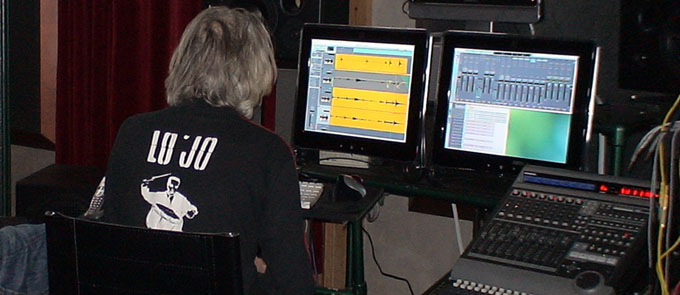
Once back in England, work was interrupted by a summer of serious sporting events and an extended period of very hot weather. The lure of a sun lounger, cool pool and long drink in front of cricket, Wimbledon and of course the World Cup meant that the studio was not the place to be. Consequently, it wasn’t until late August / early September that we saw the return of Paul Kendall once more.
With Joe having provided vocals for five or six possible tracks, Alan still had two that demanded a female voice. After extensive research, he came across Carla Trevaskis via an associate at Mute Records. Born in Portsmouth, Carla has been involved in music since the age of 14 and performed live on a regular basis in the capital. Together with an expressive range and control, Carla brought an enthusiastic approach to her recording session and spent three days in October at The Thin Line contributing lead vocals for two main tracks and additional backing vocals throughout the album.
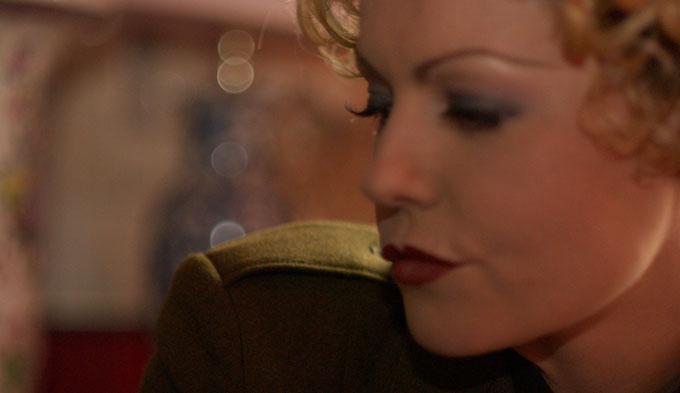
Alan: “I felt strongly that the album needed the balance of a complete opposite voice to Joe’s. I had a couple of tracks that I’d always imagined would suit a woman.”
Carla: “I was aware of Alan’s work in Depeche Mode but not Recoil. The first thing that struck me was the amazing production and the attention to detail, which was faultless. Secondly, the string arrangements were so beautiful and epic and I love the way that Alan sets up a mood for you and takes you on an emotional journey. He is great to work with as he knows exactly what he wants but he isn’t opposed to experimentation so the recording went really smoothly.”
Alan and Paul then threw themselves into serious mixing until the Xmas break, followed by an intensive month of tweaking during January 2007. The mastering was undertaken during February and March by Simon Heyworth. Alan and PK made a special trip to Simon’s studio in Devon to further delve into the dark art of transferring their studio sound onto CD.
“We spent a lot more time on this part of the process than I’d anticipated – and it was a real eye-opener (should I say ear-opener). Many people will be familiar with the current volume war that exists. In other words, how much apparent level can you get onto a CD. I didn’t want to get too involved in all that since this involves incredible amounts of digital limiting or compression. The cut we ended up with isn’t particularly ‘loud’ but does, hopefully, retain all the dynamics – something which seems to be sorely lacking in today’s music culture.”

During the early part of February, the album was also mixed for 5.1 Surround Sound by Alan and Paul at The Thin Line and finally mastered, again by Simon (who was responsible for the recent Depeche Mode 5.1 mastering). Mixing in 5.1 is particularly advantageous where Recoil is concerned – the result being an all-encompassing environment that seems to envelope the listener and allows them to fully appreciate the myriad of sounds and effects that make up each track.
Around this time Alan began to think about a title for the album.
“l’ve said before that completing an album is a conceptual puzzle, trying to make sense of what others bring. Some rationale normally evolves by choosing the right people and leaving them to their own lyrical devices. I don’t like to impose boundaries although, once their souls have been captured on hard disc, I reserve the right to re-structure their performances. That way I can entwine their words within the Recoil landscape and hopefully create the overall continuity. Towards the end of a project, some sort of concept naturally arises, albeit a loose one, which gives us a way forward for a title and to produce the artwork.
In this case, the lyrics from Joe seemed to deal with the fallout from religious doctrine and also incarceration, both physical and mental. Together with Carla’s ‘prayer’ and her words to ‘Intruders’, it set me thinking about how we seem to have learnt nothing from past experiences and our so called ‘civilised’ world is still awash with personal and global atrocities. From suicide bombers in the Middle East, to ethnic cleansing in the Balkans; from the homophobic rhetoric of the Christian fundamentalist preacher, to the activities of Western governments engaged in their ‘war on terror’. We are all ‘subhuman’ in somebody’s eyes”

Artwork was commissioned to Jesse Holhorn whose grasp of Alan’s simple brief for ‘subHuman’ resulted in truly arresting images. Jesse pitched his ideas as: “a modern visualisation emphasising the disregarded lifeform that is known as ‘subHuman’. Represented by mannequins, they emerge as faceless, autonomons with no opinions – moral degenerates to the powers that be, created by world tragedy. The photography captures the mannequins in real life situations, going about everyday life as recyclable worthless beings.”

